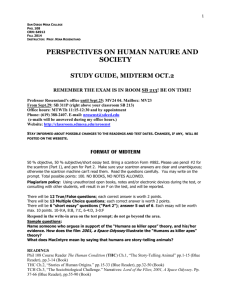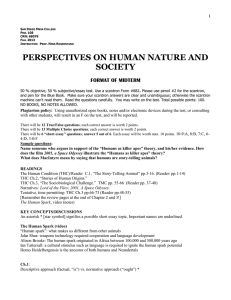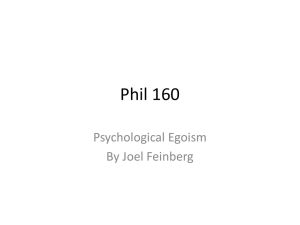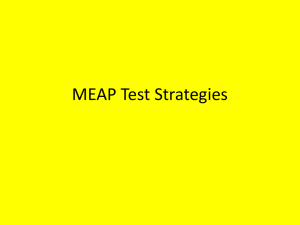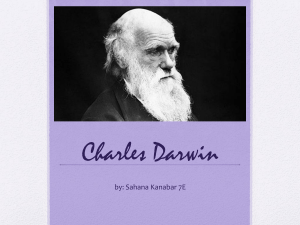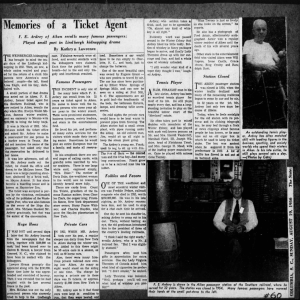midterm study guide - San Diego Mesa College
advertisement
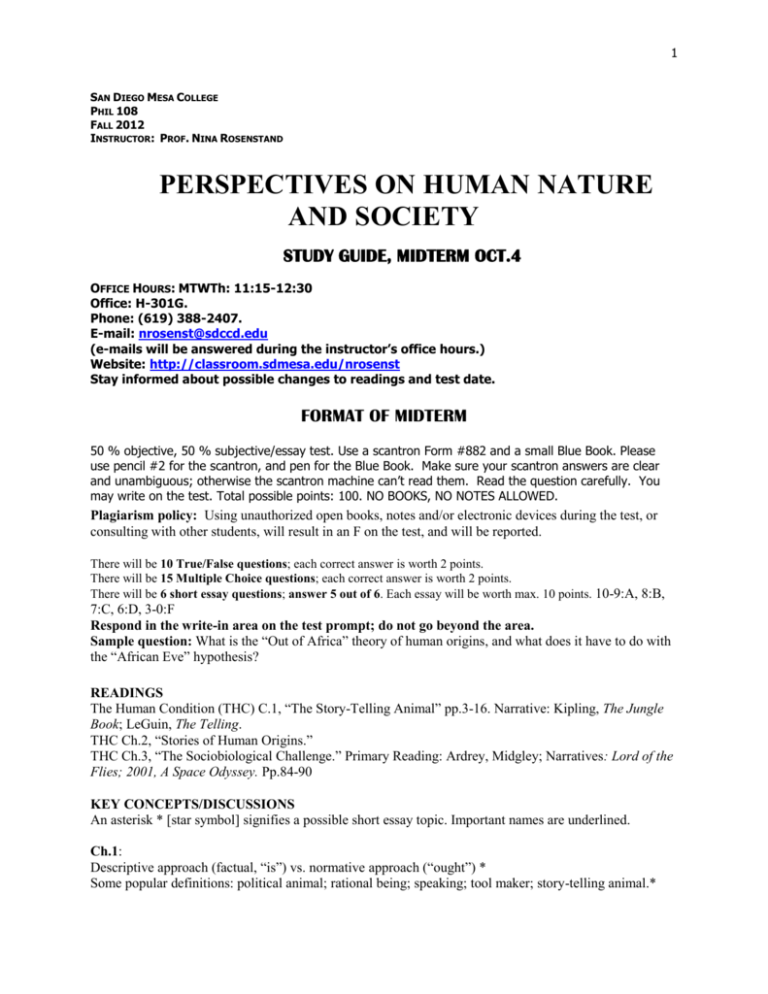
1 SAN DIEGO MESA COLLEGE PHIL 108 FALL 2012 INSTRUCTOR: PROF. NINA ROSENSTAND PERSPECTIVES ON HUMAN NATURE AND SOCIETY STUDY GUIDE, MIDTERM OCT.4 OFFICE HOURS: MTWTh: 11:15-12:30 Office: H-301G. Phone: (619) 388-2407. E-mail: nrosenst@sdccd.edu (e-mails will be answered during the instructor’s office hours.) Website: http://classroom.sdmesa.edu/nrosenst Stay informed about possible changes to readings and test date. FORMAT OF MIDTERM 50 % objective, 50 % subjective/essay test. Use a scantron Form #882 and a small Blue Book. Please use pencil #2 for the scantron, and pen for the Blue Book. Make sure your scantron answers are clear and unambiguous; otherwise the scantron machine can’t read them. Read the question carefully. You may write on the test. Total possible points: 100. NO BOOKS, NO NOTES ALLOWED. Plagiarism policy: Using unauthorized open books, notes and/or electronic devices during the test, or consulting with other students, will result in an F on the test, and will be reported. There will be 10 True/False questions; each correct answer is worth 2 points. There will be 15 Multiple Choice questions; each correct answer is worth 2 points. There will be 6 short essay questions; answer 5 out of 6. Each essay will be worth max. 10 points. 10-9:A, 8:B, 7:C, 6:D, 3-0:F Respond in the write-in area on the test prompt; do not go beyond the area. Sample question: What is the “Out of Africa” theory of human origins, and what does it have to do with the “African Eve” hypothesis? READINGS The Human Condition (THC) C.1, “The Story-Telling Animal” pp.3-16. Narrative: Kipling, The Jungle Book; LeGuin, The Telling. THC Ch.2, “Stories of Human Origins.” THC Ch.3, “The Sociobiological Challenge.” Primary Reading: Ardrey, Midgley; Narratives: Lord of the Flies; 2001, A Space Odyssey. Pp.84-90 KEY CONCEPTS/DISCUSSIONS An asterisk * [star symbol] signifies a possible short essay topic. Important names are underlined. Ch.1: Descriptive approach (factual, “is”) vs. normative approach (“ought”) * Some popular definitions: political animal; rational being; speaking; tool maker; story-telling animal.* 2 Aristotle’s meaning of political animal=social animal living in a city-state Alasdair MacIntyre: We must rediscover our cultural identity through the stories of our culture and families.* Gives personal identity through narrative unity.* Problem: What if we don’t approve of the history of our culture? narrative quest * Primary Reading: Kipling, The Jungle Book: animals appear to be the wise ones, while humans are irrational and emotional* Ursula le Guin, The Telling: A planet where stories are banned. The wise ones: Humans need stories to make sense of life and give us direction, because we don’t have instincts. Ch.2: Mircea Eliade: All cultures tell stories of human origins in the time of the beginning, “in illo tempore” * Cyclical time perception: time repeats itself and must be renewed. Linear time perception: Time doesn’t repeat itself. * Christian Creationism: Literal interpretation of Bible. Creation happened 6000 years ago. Belief system. * Theory of Evolution: based on geological and fossil record. Scientific approach. * Intelligent Design Theory: (1) A vast intelligence must have created the universe, because of its complexity (2) the same as Christian Creationism [from your notes] Charles Darwin: theory of natural selection. Karl Popper: An empirical scientific theory must test itself, and allow for the possibility that it might be wrong: Principle of falsification Punctuated equilibrium: evolution in bursts because of natural disasters. Human evolution theory, most famous finds: Ardipithecus (“Ardi”), Australopithecus afarensis (Lucy); Homo habilis; Homo erectus; Neandertal Out of Africa theory: humans all share a common ancestry in Africa dating back 200,000 years. Around 60,000 years ago groups of humans migrated out of Africa. * “Latest spins” on human evolution: * African Eve hypothesis (same as “Out of Africa theory”) * Multiregional continuity The Aquatic Ape * The Outer Space Connection Human evolution theories and politics: Descriptive theories inspire normative, political interpretations Example: Kennewick Man: Who was first on the American continent? Example of American Indian tribal creationism* Primary Reading: Darwin: Evolution of social animals generally works through the individual benefiting the group. If we are descended from weaker creatures it would explain our social flexibility. Ch.3 Sociobiology: Human biology influences all human social structures 3 blows to the human self-assurance: Copernicus, Darwin, and Freud Darwin’s critics: “Survival of the fittest” is a circular definition; Darwin defended capitalism through his theory of natural competition. He believed in eugenics; he introduced moral values into his idea of evolution. Raymond Dart, paleoanthropologist: Introduced theory of humans as killer apes (cave fossils) Robert Ardrey, playwright: the territorial imperative (fight for territory). Humans are killer apes, “Cain’s children.” Weapons and aggression enhanced our intelligence.* Ardrey found support in Raymond Dart’s theory of killer apes.* 2001, A Space Odyssey, exemplifies Ardrey’s and Dart’s theory * 3 Don Johansen, paleoanthropologist challenges the “killer ape” theory: Early humans were prey, not predators * Konrad Lorenz, biologist: We are not killer apes, just cranky apes who kill. Predators don’t usually kill members of own species.* Rosenstand: New research: Humans do show reluctance to harm other humans [from your notes] Rosenstand: Our story of human prehistory changes with the needs of the changing times. Evolutionary psychology: Human biological history influences individual psychology Psychological egoism: Everyone is selfish by nature (descriptive theory) * Problem with Psych. Egoism: can’t be falsified (Popper) Ethical egoism: Everyone ought to be selfish (normative theory) Aristotle: we should look after ourselves because (1) we only have this life, and (2) we’ll be happier in a society with other people who also look after themselves while being social. Plato’s Republic: Contains first theory of a social contract [from your notes] Plato’s story of the ring of Gyges. Told by Glaucon to prove everyone is selfish. * Thomas Hobbes: Everyone is selfish, focused on self-preservation. All emotions are based on attraction or repulsion. * 3 kinds of metaphysics: materialism, dualism, and idealism. [from your notes] Hobbes was a materialist, a psychological egoist, an ethical egoist, a monarchist, and an atheist. Sigmund Freud: Our dreams reveal unconscious self-centeredness: wish-fulfillment. Look beyond manifest dream content to the latent dream thoughts. The dream work helps us understand our dreams.* Parapraxes reveal hidden thoughts. The pleasure principle vs. the reality principle. The Oedipus complex. [all of Freud *] Edward O. Wilson: genetics explain all human behavior. 4 characteristics shared by humans and other primates. Richard Dawkins: The selfish-gene theory: humans and animals are programmed to help their genes survive.* Mary Midgley: Not all behavior is selfish; altruistic behavior is an extended parent-children relationship.* Richard Leakey: hunting wasn’t as important as gathering. The basket may be as old as the weapon. Riane Eisler: In ancient times humans were less aggressive and had a gender-equal partnership society; then aggressive invaders came, and established a male-dominated dominator society. The naturalistic fallacy: Going from an “is” to an “ought” without stating the hidden premise. Jane Goodall: aggression and caring are human potentials Primary Reading Ardrey: Early human history show primate aggression; all inventions are due to warfare, but we must learn to control out aggression.* Midgley: Not all acts are done for purely selfish reasons. Motives for altruism have been misunderstood. Primary human feature is sociability.* Narratives Lord of the Flies: civilization is a veneer; human selfishness and aggression is just beneath the surface*, 2001: A Space Odyssey: The monolith makes early hominids intelligent, and they use their intelligence to create weapons.*
